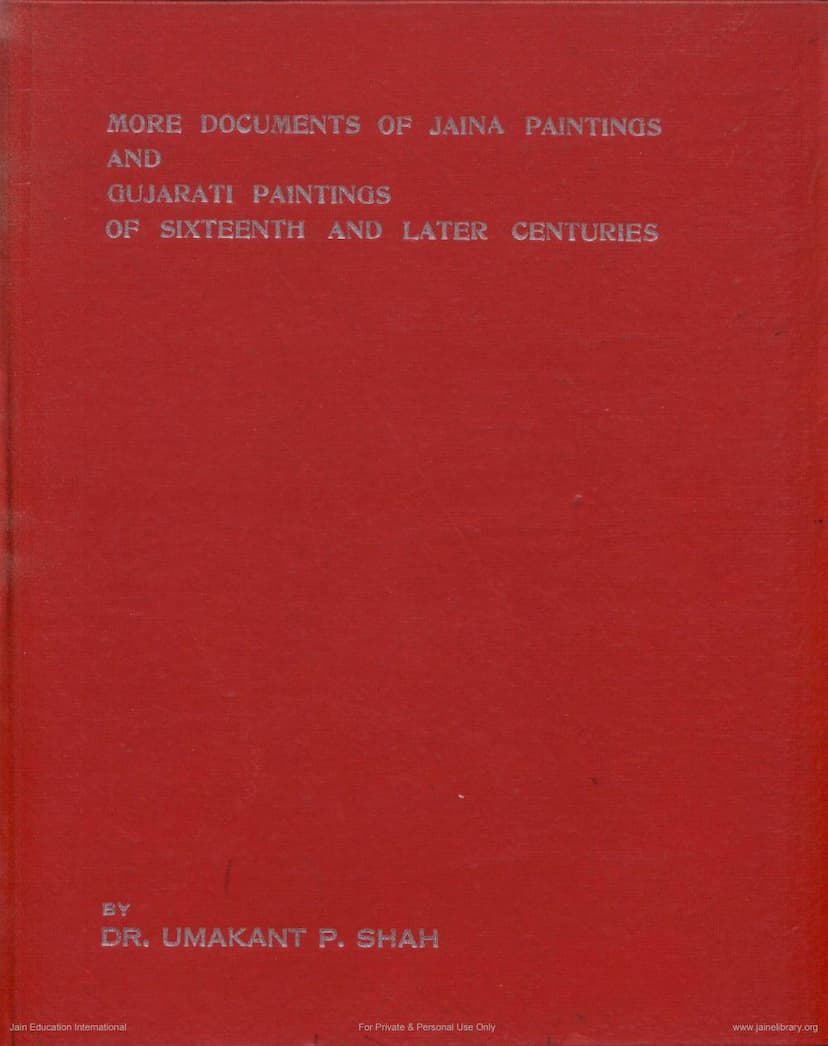More Documents Of Jaina And Gujarati Paintings
Added to library: September 2, 2025

Summary
This document is a scholarly monograph titled "More Documents of Jaina and Gujarati Paintings of Sixteenth and Later Centuries" by Dr. Umakant P. Shah, published by the L. D. Institute of Indology, Ahmedabad in 1976. It expands upon a lecture delivered by the author and aims to shed light on new findings in miniature painting from Western India, specifically focusing on trends in Gujarat over the past three to four centuries.
The monograph aims to:
- Present new documents of miniature paintings from Western India, particularly those of the sixteenth century and later.
- Highlight materials that will aid in understanding the evolution of painting styles in various parts of Gujarat during recent centuries.
Key Themes and Contributions:
-
Tracing the Origins of Western Indian Miniature Painting:
- Dr. Shah meticulously traces the stylistic origins of Western Indian miniature painting, referencing early examples from the 10th and 11th centuries.
- He analyzes incised figures on copper-plate grants (like those of Paramāra Vākpatirāja and Bhojadeva) to identify key traits such as the pointed nose, three-quarters profile, and squarish jaw, which became characteristic of this style.
- He argues for an earlier style that existed alongside and was gradually influenced by the emerging Western Indian idiom, as seen in the Harsola copper plate grant of Siyaka (949 AD).
- He discusses the Ogha-Niryukti-Vitti and Daśavaikālika-sūtra-țīkā manuscript (c. 1060 AD) as a significant find pushing back the history of Western Indian miniature painting to the mid-11th century, and potentially the early 10th century based on the Harsola plates.
- He critically examines the Sarasvati miniature (1127 AD), suggesting it might represent a Deccan influence or a painter from the Deccan working in Gujarat, rather than being a purely Western Indian style.
-
Literary Evidence for Painting:
- Dr. Shah delves into literary sources like the Kuvalayamāla-kahā (778-79 AD) and Samarāiccakahā to understand contemporary practices and appreciation of painting.
- He highlights the importance placed on precise lines (rekhanyasa), composition, and the depiction of emotions (bhāvas) as indicators of a painter's skill.
- The mention of Citraśālā (halls of paintings) attached to Jain shrines, like the one built by Kumārapāla at Patan in the 12th century, is noted.
-
Analysis of Later (14th-16th Century onwards) Gujarati Painting:
- The monograph details several newly discovered or less-known illustrated manuscripts, providing dating and provenance where possible.
- Kalpasūtra and Kālakakathā manuscripts from the 14th and 15th centuries are discussed, highlighting stylistic shifts, increased use of colors like green and gold, and the emergence of the "Anahilwād-Patan style" or "Gujarati style."
- Examples like the Kalpasūtra dated V.S. 1377 (1320 AD), the Satapadi manuscript (V.S. 1294/1271 AD), and the Uttarādhyayana Sukhabodhā-vřlli (first half of 14th century) are analyzed for their stylistic features.
- Secular texts like the Vasanta Vilāsa scroll and the Itihāsa-Samuccaya are presented to show the broader application of painting styles beyond religious themes.
- The Panca-tirthi scroll (1433 AD) from Champaner is noted for its lively depiction of animals and figures, indicating dynamism in the art.
-
Emergence of New Styles (16th Century onwards):
- Dr. Shah identifies and discusses new trends emerging in the 16th century, leading to distinct schools or styles.
- He focuses on the "new Gujarati style of the Sixteenth century," exemplified by manuscripts like the Bhāgavata Daśama-Skandha (1610 AD, painted by Govinda), the Bhāgavata (1598 AD), the Rājapraśnīya Sūtra, and the Bālagopāla-Stuti.
- He analyzes stylistic characteristics of this period, including changes in facial features (elimination of pointed noses, dropped farther eye), typical turbans, and a departure from earlier conservatism.
- The Mātar Samgrahaṇī (1583 AD) painted by Govinda is considered a pivotal work, setting a standard for later Samgrahaṇī manuscripts and embodying the new Gujarati style.
- The Surat style of the late 17th century is discussed, referencing the Sri-Candra-Rāsa (1659 AD) and a Devī-Māhātmya (1719 AD), noting features like heavy heads on stunted figures and thick lines.
- The Sirohi School is also mentioned, with its connection to Gujarati art and the possibility of its prevalence in Gujarat in later centuries.
-
Categorization and Preservation of Jaina Painting:
- The monograph emphasizes the vast corpus of illustrated Jaina manuscripts, scrolls, wooden book-covers, and canvas patas available in Western India.
- It highlights the role of scholars and collectors like Agama-Prabhākara Muni Sri Punyavijayaji in preserving and making accessible these valuable documents.
- A comprehensive list of over 90 types of illustrated manuscripts and materials found in Jaina collections is provided, serving as a guide for future research.
- The text also touches upon less common sources like manuscript folders and decorative boxes, showing the pervasive influence of art in Jaina monastic and cultural life.
In essence, Dr. Umakant P. Shah's "More Documents of Jaina and Gujarati Paintings" provides a crucial and detailed account of the development of painting in Western India, particularly Gujarat, from its early stages in the 10th-11th centuries through to the 18th and 19th centuries. It contributes significantly to art history by introducing new evidence, re-evaluating existing understanding, and establishing a more precise timeline and stylistic progression for this rich artistic tradition.